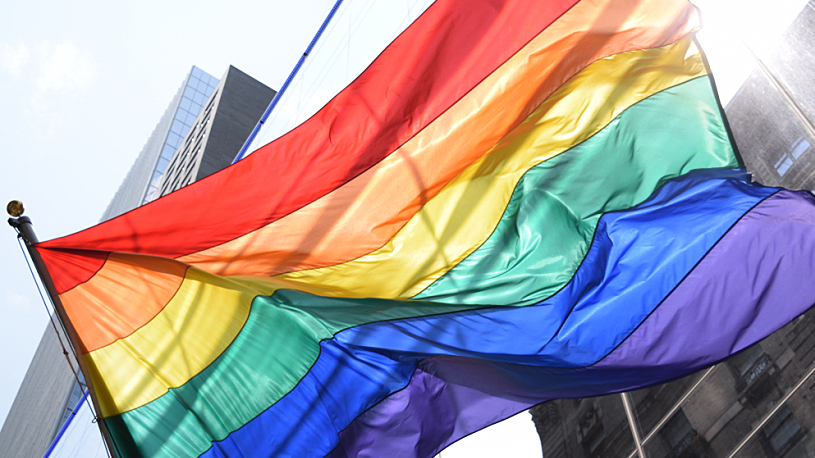Celebrating Pride in the Workplace Is a Year-Round Affair [2024 Update]

LGBTQ+ Pride Month is an excellent time for organizations worldwide to demonstrate support for the LGBTQ+ community. It's also something organizations can celebrate throughout the year to enhance their commitments to diversity, equity and inclusion (DE&I) and intersectionality.
Supporting the LGBTQ+ community, fostering inclusion and celebrating Pride in the workplace can happen in many ways throughout the year and can keep your organization strong. Diversity, equity and inclusion are values employees want in an employer and customers want in a brand. Both groups increasingly want your organization's year-round support to be clear and undeniable in what you say and do.
To help entrench DE&I practices in your organization, here are some ideas and best practices for supporting an inclusive work environment and celebrating Pride at your organization.
Take part in community Pride events
Pride Month provides an excellent opportunity to implement your internal DE&I position statements. Whether it's your first time venturing out or you have a long-standing tradition, you can usually find events to participate in or sponsor, such as parades, festivals, discussion panels, wellness activities and more. You can also host Pride events during June. Throughout the year, you could consider participating in Spirit Day in October or Transgender Day of Visibility in March.
Amplify LGBTQ+ employees' voices
One of the best ways to work on continuously celebrating Pride in the workplace is to uplift the voices of employees who are part of the LGBTQ+ community. Inviting feedback from employees of diverse backgrounds and incorporating their experiences and insights will give you better-informed decisions on your organization's policies, programs and other efforts.
Build awareness through learning opportunities
Employers can foster inclusion by encouraging employees to learn about the LGBTQ+ community. You might offer pronoun training, education around inclusive language, employee resource groups (ERGs) and panel discussions with LGBTQ+ employees.
Leaders can set an example by consistently using employees' pronouns and preferred or chosen names and avoiding gendered language when communicating with employees. Mistakes are bound to happen, and it's important to acknowledge the lesson when someone points out an error. Often, simply thanking the person for identifying the mistake is preferable to apologizing.
Donate to or volunteer with LGBTQ+ organizations
Research organizations before committing support to ensure your efforts make a helpful difference. You may want to consider partnering with smaller local organizations because they can have a more direct impact on your immediate community. Get employees involved by asking them to nominate organizations or help review options and recommend to leadership where support should go.
Use transparent, inclusive hiring practices
Inclusive organizations openly show how they work to reduce bias in recruitment. An inclusive recruiting process is essential to ensure your commitment to DE&I endures. Incorporate inclusive language and representation in your recruiting content and consider partnering with organizations that support LGBTQ+ workers in your industry. Organizations that are thoughtful about the employee experience and their offerings, such as an LGBTQ+ inclusive dress code policy, benefits and ERGs, can more readily prepare leaders with related recruitment resources.
Your efforts will be more successful if you engage your current workforce by encouraging employee referrals, featuring employees in recruitment marketing content and inviting their feedback on your recruiting practices.
Embrace DE&I as a journey, not a destination
Working toward a more diverse, equitable and inclusive work environment is an ongoing journey, not a goal to be completed. You won't reach a time when you "conclude" your DE&I work — expectations will continue to evolve, and new ones will arise. But it's essential to get started.
Many organizations are implementing data-driven approaches to DE&I, offering leaders insight into the current states of their workforces, including visibility into leadership, promotions for people who identify as LGBTQ+ and opportunities for expanded benefits by head count and by nonbinary and transgender self-ID.
Even global organizations operating in countries with restrictions and regulations on the use of data relevant to LGBTQ+ are finding ways to offer a culture of inclusion and belonging to their employees, such as through informal surveys instead of reporting and data analytics. Rooting DE&I efforts in data allows leaders to set goals and benchmarks, create initiatives and track progress — all crucial to meaningful improvement. When organizations identify their diversity gaps using data, they can define the problem and take steps to implement a solution. Continually tracking the progress of those changes allows companies to improve over time.
Employers need to be transparent with their values and actions. Companies with successful DE&I initiatives are committed to creating and maintaining a diverse, equitable and inclusive workplace during Pride Month and throughout the year.
To foster DE&I in your workplace, visit our DE&I Resource Hub.



